Search the Special Collections and Archives Portal
Search Results
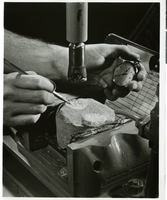
Photograph of a drill bit at the Hughes Tool Co., Houston, Texas, circa 1950s
Date
1950 to 1959
Archival Collection
Description
Transcribed from attached press release: "LITTLE BIT Only an inch and a quarter in diameter, this "microbit" enables engineers at the Hughes Tool Company, Houston, Texas, to estimate the performance of full-size bits for the oil drilling industry. The company operates the largest testing laboratory of its kind anywhere in the world and produces thousands of rock bits necessary to drill deeper and deeper as the world's shallow oil wells have become exhausted. Howard Hughes terms the Hughes Tool company the "keystone" of his industrial empire."
Image
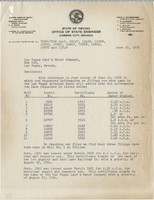
Letter from Hugh A. Shamberger (Carson City) to Las Vegas Land and Water Company (Las Vegas), June 21, 1950
Date
1950-06-21
Archival Collection
Description
List of wells owned by the Las Vegas Land and Water Company and the amount of water granted to each.
Text
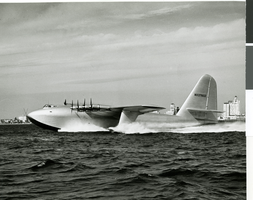
Photograph of the HK-1, Hughes Flying boat, as it returns from its historic test flight, November 2, 1947
Date
1947-11-02
Archival Collection
Description
A side view of the HK-1, Hughes Flying Boat, the world's largest plane, which successfully completed its first flight. The eight 3,000 horsepower engines lifted the craft from the waters of Los Angeles Harbor with Hughes at the controls. The plane is 219 ft long.
Image
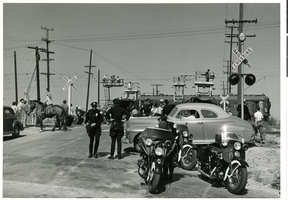
Photograph of a crowd watching the fuselage of Hughes Flying Boat in transit, California, June 16, 1946
Date
1946-06-16
Archival Collection
Description
Transcribed from stamp on back of photo: "June 16, 1946; Hughes Aircraft Photo." Crowds and policeman watching as a section of Howard Hughes' "Spruce Goose" or "Flying Boat" was being moved (with a police escort) from the Hughes Aircraft plant in Culver City, California to Terminal Island in the Los Angeles Harbor where the plane was assembled June 1946. The men are raising the power lines so the fuselage can pass under.
Image
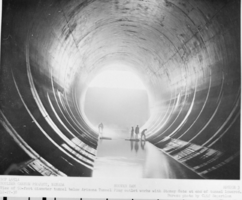
Film transparency of people standing in tunnel, Hoover Dam, December 27, 1938
Date
1938-12-27
Archival Collection
Description
Black and white image of Hoover Dam with the following printed description: "View of 50-foot diameter tunnel below Arizona Tunnel Plug outlet works with Stoney Gate at end of tunnel lowered." Note: Boulder Dam was officially renamed Hoover Dam in 1947.
Image

View of New Orleans from across the Mississippi River, New Orleans, Louisiana: panoramic photographs
Date
1981-01-25
Archival Collection
Description
From the Bob Paluzzi Panoramic Photographs
Image
Settlement statements for The Outlaw, advice of credit, National City Bank of New York, New York, approximately 1946 to 1949
Level of Description
File
Archival Collection
Howard Hughes Film Production Records
To request this item in person:
Collection Number: MS-01036
Collection Name: Howard Hughes Film Production Records
Box/Folder: Box 247 (Restrictions apply)
Collection Name: Howard Hughes Film Production Records
Box/Folder: Box 247 (Restrictions apply)
Archival Component
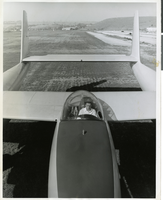
Photograph of Howard Hughes sitting in the cockpit of the XF-11 preparing for his first test flight in Culver City, California July 7, 1947
Date
1947
Archival Collection
Description
Transcribed from press release attached to back of photo: "NEW PHOTO PLANE TEST-FLOWN CULVER CITY, California, July 7 -- Howard Hughes, who designed and built the new FX-11 reconnaissance plane in conjunction with Air Materiel Command engineers, sits in the pilot's bubble-glass canopy preparing for the first test flight. One of the world's fastest long-range photo planes, the XF-11 can attain a speed of more than 400 miles per hour, Army officials said. It is powered by two 3000-horsepower radial engines with eight-bladed contra-rotating propellers. Outstanding features include a full-span flap, unique eight-camera layout, and exceptionally fast take-off." Transcribed from photo sleeve: "Howard Hughes sits in the cockpit of the XF-11, a reconnaissance plane that Hughes built and designed in conjunction with Air Materiel Command engineers. Hughes is preparing for his first test flight in Culver City, California July 7, 1947.
Image
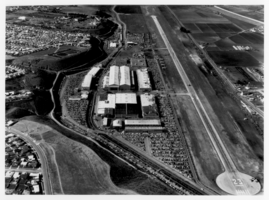
Aerial photograph of Hughes Airport, Culver City, California, circa early 1960s
Date
1960 to 1965
Archival Collection
Description
Aerial view of the airport at Hughes' aircraft plant in Culver City, California. The airport's runway was in operation from 1941 to 1985.
Image
Pagination
Refine my results
Content Type
Creator or Contributor
Subject
Archival Collection
Digital Project
Resource Type
Year
Material Type
Place
Language
Records Classification

